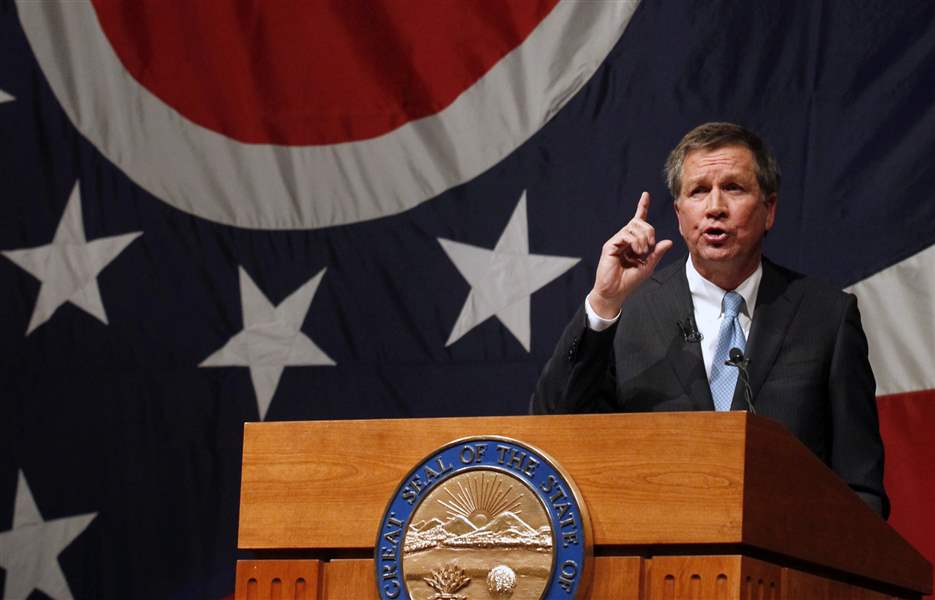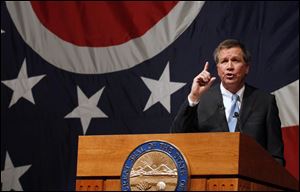
OHIO BUDGET
GOP plan for schools helps TPS, hurts others
Suburban districts want to wait and see
4/15/2013
Gov. John Kasich funding plan would have increased basic aid to schools by 6 percent in the first year of the two-year budget and 3.2 percent in the second. In all, the amount of state funds funneled through the new basic aid for schools would be $6.2 billion in fiscal year 2014, beginning July 1, and $6.4 billion the following budget year.
The Blade/Lori King
Buy This Image

Gov. John Kasich funding plan would have increased basic aid to schools by 6 percent in the first year of the two-year budget and 3.2 percent in the second. In all, the amount of state funds funneled through the new basic aid for schools would be $6.2 billion in fiscal year 2014, beginning July 1, and $6.4 billion the following budget year.
When Gov. John Kasich’s school-funding proposal didn’t live up to his pledge that “if you are poor, you’re going to get more,” many school officials responded with surprise and dismay.
Now, with the Ohio House Republicans' proposal that spreads school funding out more evenly, some of that dismay has been dampened. But with a lengthy legislative process still to come and changes likely, most area school officials simply say they'll watch and wait to see what happens.
Mr. Kasich’s funding plan would have increased basic aid to schools by 6 percent in the first year of the two-year budget and 3.2 percent in the second. In all, the amount of state funds funneled through the new basic aid for schools would be $6.2 billion in fiscal year 2014, beginning July 1, and $6.4 billion the following budget year.
But preliminary breakdowns of how the formula would affect school districts showed that growing, relatively wealthier suburban districts in metro Toledo would receive significant increases in funds next year, while state funding for struggling Toledo Public Schools would stay flat.
While no school district would receive less money than it did last year, about 60 percent of districts would have no funding increases.
The House plan, released last week, uses similar funding levels, and reduces by about half the districts that would get flat funding, by increasing funding for special education and capping the increases for all districts at 6 percent.
Under that plan, TPS would get the maximum increase both years, receiving $210.7 million in 2014 and $223.3 million in 2015, up from $198.8 this fiscal year. While that would be good news for the district, TPS Superintendent Jerome Pecko said those numbers can, and likely will, change.

“That would be wonderful,” Mr. Pecko said of the House proposal, “but we’ve been through this before.”
Toledo Federation of Teachers President Kevin Dalton said that the increases don’t make up for cuts in state aid the district saw in recent years. District Treasurer Matt Cleland estimates state funds per pupil under the plan would only be equal to 2009 levels. And he said the district would likely lose some transportation funds under the formula used in the House.
Still, TPS is likely the big winner locally, if you compare the House plan to the governor’s. Some of the area’s suburban districts, which would have seen major increases in state aid in the Kasich plan, now would get much smaller boosts.
The Perrysburg district, for instance, would have had a 25 percent increase in state funds in the original proposal, but now would only get 6 percent more. Perrysburg Superintendent Tom Hosler said he wasn’t expecting the House plan would be the final product; it could change in the House, and the Ohio Senate still has to propose its own school budget.
That delay makes it hard for district administrators to plan their budgets in advance, because they don’t know how they will be funded by the state. But he wasn’t lamenting the fact that some districts made out better than his in the latest proposal.
“In the business world, there’s winners and losers,” he said, “but we can’t talk about winners and losers anymore [with schools].”
Washington Local also went from a 25 percent funding increase to 6 percent in the competing plans, but Treasurer Jeff Fouke brushed off the changes.
“I never expected to get that 25 percent increase,” he said. “This happens every two years. You get the proposal, everyone gets excited, and then it changes.”
He too was more interested in getting a firm budget in place so he could plan for the future.
The House Finance and Appropriations Committee is scheduled to vote Tuesday on the budget proposal, and the full House will vote on Thursday.
Contact Nolan Rosenkrans at: nrosenkrans@theblade.com, 419-724-6086, or on Twitter @NolanRosenkrans.